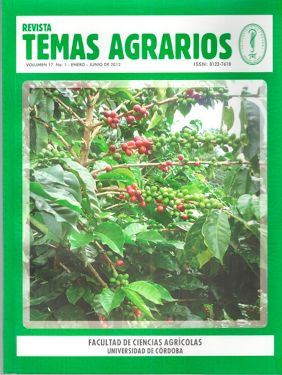Identification of soy, bean and barley adulterants in roasted and ground coffee using FTIR-PAS
Identificación de adulterantes soya, fríjol y cebada en café tostado y molido utilizando EFA-IRTF

This work is licensed under a Creative Commons Attribution-NonCommercial 4.0 International License.
Show authors biography
Detection and quantification of adulterants in processed coffee is very important, because some sensorial characteristics and grain size are readily reproducible with products as cereals, legumes, seeds, roots and bad quality coffee after roast and ground. In this work, spectral characteristics of medium-roasted coffee powder that was blended to different concentrations with barley, bean and soy, are defined. This was done using infrared photoacoustic (PA) spectroscopy with Fourier transform. The samples were placed into a PA cell, which was adapted to a spectrophotometer as accessory for measuring. Principal Component Analysis (PCA) was applied on the spectra derivatives in order to estimate the effect of each adulterant. It was noted from the spectra behavior and PCA, that some characteristics of coffee, related to lipids and carbohydrates content, are modified in a different way when it is blended with the adulterants in different proportions. This analysis strengthens the definition of criteria that can be used for discriminating roasted and ground coffee, according to the degree of purity.
Article visits 1079 | PDF visits
Downloads
- Bell, A.G. 1880. Production and reproduction of sound by light. American Journal Of Science 15(2):207-305.
- Cordella, C., Moussa, A., Sbirrazzuoli and Lizzani-Cuvelier, L. 2002. Recent developments in food characterization and adulteration detection: techniqueoriented perspectives. Journal of Agricultural and Food Chemistry 50:1751-1764.
- Cortés-Ibarra, M., Urriolagoitia-Calderón, G., Hernández-Gómez, L., Mendoza-López y Rodríguez-García, M. 2008. Aplicación de celda fotoacústica diferencial en la determinación de la permeabilidad de agua en hueso descalcificado. Revista Colombiana de biotecnología 10(2):15-16.
- Dumas, F.L., Marciano, F.R., Oliveira, L.V.F., Barja, P.R. y Acosta-Avalos, D. 2007. “Photoacoustic monitoring of the absorption of isotonic saline solution by human mucus”, Medical Engineering & Physics 29:980-983.
- Gordillo-Delgado, F., Herrera-Cuartas, J.A., Marín-Ramírez, L.F., Ariza-Calderón, H., 2004. Estudio de la pigmentación de café orgánico tostado y molido usando la técnica fotoacústica. Revista Colombiana De Física 36(2):286.
- Gutiérrez, A. y Giraldo, J. 2011. Técnica fotoacústica aplicada a la determinación de propiedades térmicas de muestras de silicio poroso. Revista Mexicana De Física 57(2):99-105.
- Lyman, DJ., Bench, R., Dell, S., Merle, S. y Murray-Wigelath, J. 2003. FTIR-ATR analysis of brewed coffee: effect of roasting conditions. J Agric Food Chem 51(11):3268-72.
- Mcclelland, F., Jones, Roger, W. And Bajic, Stanley, J. 2002. FT-IR Photoacoustic spectroscopy ames laboratory - us doe 107 spedding hall Iowa state university.
- Oliveira, R., Oliveira, L., Franca, A. y Augusti, R. 2009. Evaluation of the potential of SPME-GC-MS and chemometrics to detect adulteration of ground roasted coffee with roasted barley. Journal of Food Composition and Analysis 22(3):257-261.
- Prodolliet, J., Bruelhart, M., Lador, F., Martinez, C., Obert, L., Blanc, M. y Parchet J. 1995. Determination of free and total carbohydrate profile in soluble coffee. AOAC Int. 78:749-761.
- Rafael, C.S., Leandro, S.O., Adriana, S. F. y Rodinei, A. 2009. Evaluation of the potential of SPME-GC-MS and chemometrics to detect adulteration of ground roasted coffee with roasted barley. Journal of Food Composition and Analysis 22(3):257-26.
- Rai, A. y Singh, J. 2003. Instrumentation science & technology. Perspective of photoacoustic spectroscopy in disease diagnosis of plants: A Review. 31(4):323-342.
- Reid, L. M., O’Donnell, C. P. y Downey, G. 2006. Recent technological advances for the determination of food authenticity. trends food sci. Technol 17:344-352.
- Rodríguez-Rojas, O. 2009. Principal component analysis; springer-verlag: New York p7-8.
- Rosencwaig, A. and Gersho, A. 1976. Theory of the photoacoustic effect with solids. Journal of Applied Physics 47(64):6.
- Schmid, T. y Bioanal, C. 2006. Photoacoustic spectroscopy for process analysis. analytical and bioanalytical chemistry. Publisher: Springer Berlin / Heidelberg. 384(5):1071-1086.
- Silva, L., Oliveira, L. and Franca, A. 2011. Fourier transform infra-red (FTIR) spectroscopy applied to the detection of roasted coffee adulteration with spent coffee grounds. Pure and applied chemistry international conference (food safety) p219-221.
- Souza-Santos, M. 2005. Utilização de espectroscopia em la region del infrarrojo (ftir) y quimiometria em identificacion de café tostado y molido adulterado. Curso de maestria en agronomia. Universidad Federal De Lavras De Minas Gerais-Brasil.
- Vargas, H. And Miranda, L.C.M. 1988. Photoacoustic and related photothermal techniques. Elsevier, New York 161(2):43-101.
- Vasanthan, T., Yeung, J. y Hoover, R. 2001. DextrinizacionOfstarch In Barley Flours With Thernostaable Alpha-Amylase By Extrusion Cooking. Starch/Starkevol 53(12):616-622.




















